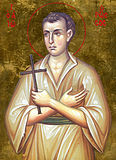

| Previous day | Next day |
| Old Style
May 27
|
Friday |
New Style
June 9
|
| First Week after Pentecost (Fast-free period). Tone 7. | No fast.
|
![]() Hieromartyr Therapontus, priest, of Sardis (3rd c.).
Hieromartyr Therapontus, priest, of Sardis (3rd c.). ![]() Translation of the relics of St. Nilus of Stolobny (1667).
Translation of the relics of St. Nilus of Stolobny (1667). ![]() St. John the Russian, confessor, whose relics are on the island of Euboea (1730).
St. John the Russian, confessor, whose relics are on the island of Euboea (1730).
Virgin-martyr Theodora and Martyr Didymus the Soldier, of Alexandria (304). St. Therapont, abbot, of Belozersk and Mozhaisk (1426). Translation of the relics (1472) of Sts. Cyprian, Photius, and Jonah, metropolitans of Kiev (1472). St. Therapontus, monk of Monza Monastery (Galich) (1597). St. Lazarus the Clarivoyant, hieroschemamonk of Pskov Caves Monastery (1824).
Viliya Icon of the Most Holy Theotokos.
Martyr Julius the Veteran, at Dorostolum in Moesia (ca. 302). St. Michael of Parekhi, Georgia (8th c.-9th c.). St. Basil of Khakhuli, son of King Bagrat III of Georgia (11th c.). Hieromartyr Helladius, bishop (6th c.-7th c.). New Hieromartyr Therapontus, priest, of Sofia (Bulgaria) (1555).
Repose of Blessed Zina of Vetluga (1960).
Thoughts for Each Day of the Year
According to the Daily Church Readings from the Word of God
By St. Theophan the Recluse

Friday. [Rom. 2:14–29; Matt. 5:33–41]
But I say unto you, That ye resist not evil (Matt. 5:39); in other words, allow yourself to be a victim of human selfishness and malice. But how can one live like that? Do not worry. He who gave this commandment is our Provider and Guardian. When you desire to live like this with complete faith from your whole soul, to not resist any evil, the Lord Himself will arrange a life for you which is not only bearable, but joyful. Furthermore, resistance in fact can irritate an aggressor even more and motivate him to invent new troubles, whereas a yielding demeanour disarms him and humbles him. Thus, if you would just suffer the first onslaught of malice, people will take pity on you and leave you alone, while resistance and revenge kindle malice, which is passed on from the individual to his family, and then from generation to generation.
Articles
 Hieromartyr Therapon the Bishop of SardisThe Hieromartyr Therapon, Bishop of Sardis suffered for Christ during the third century (the city of Sardis was in Lydia, Asia Minor). |
 St Photius the Metropolitan of KievSaint Photius, Metropolitan of Kiev and All Russia, was by birth a Greek from the Peloponnesian city of Monembasia (Malbasia). |
 St Jonah the Metropolitan of MoscowSaint Jonah, Metropolitan of Moscow and Wonderworker of All Russia, was born in the city of Galich into a pious Christian family. |







